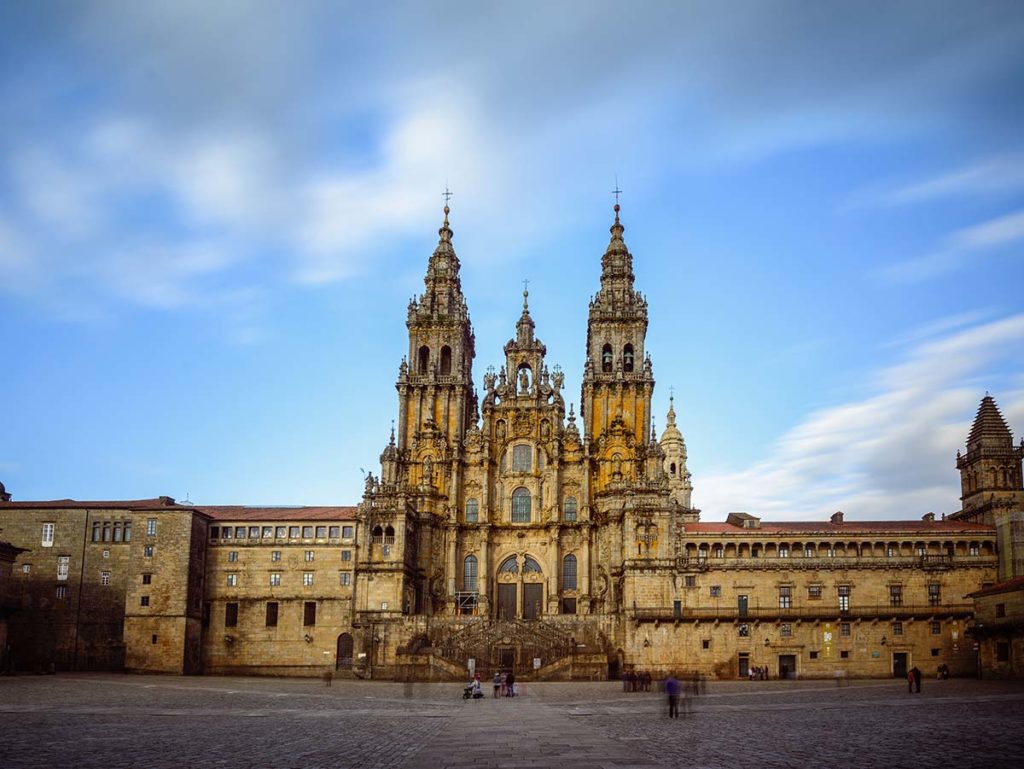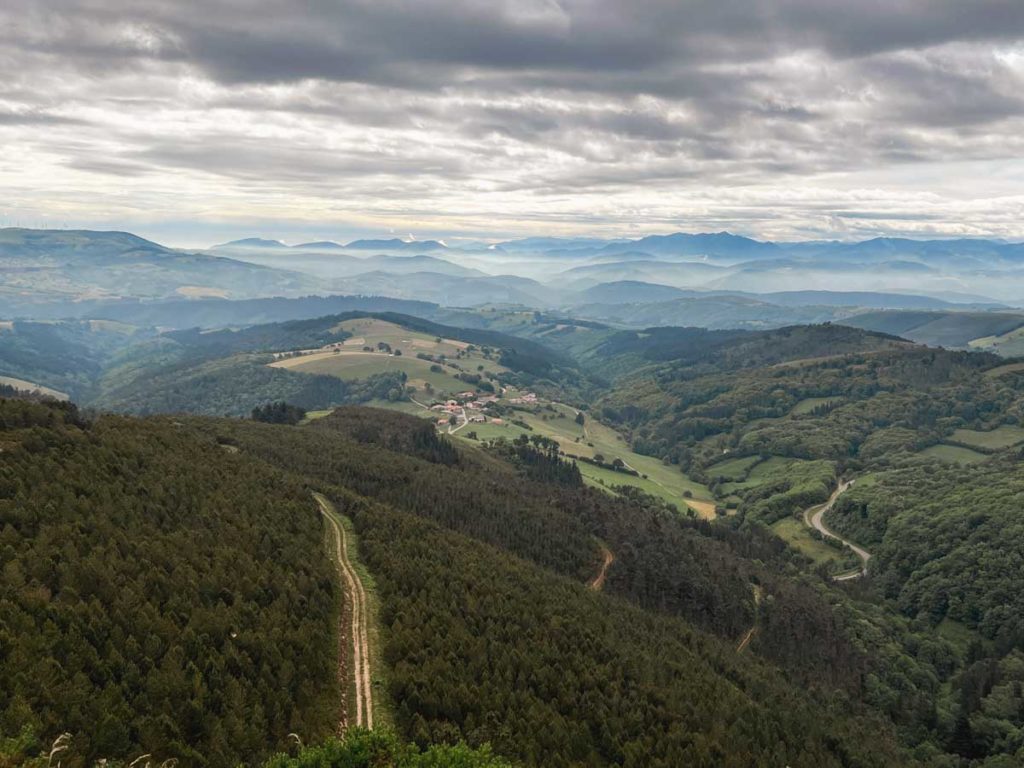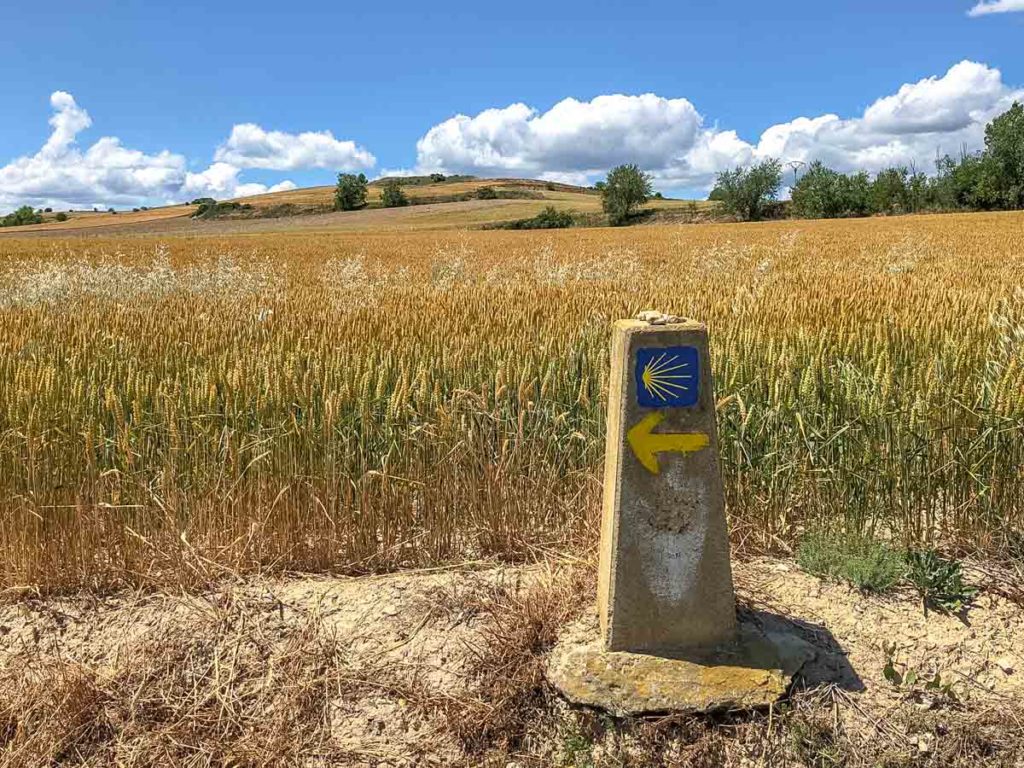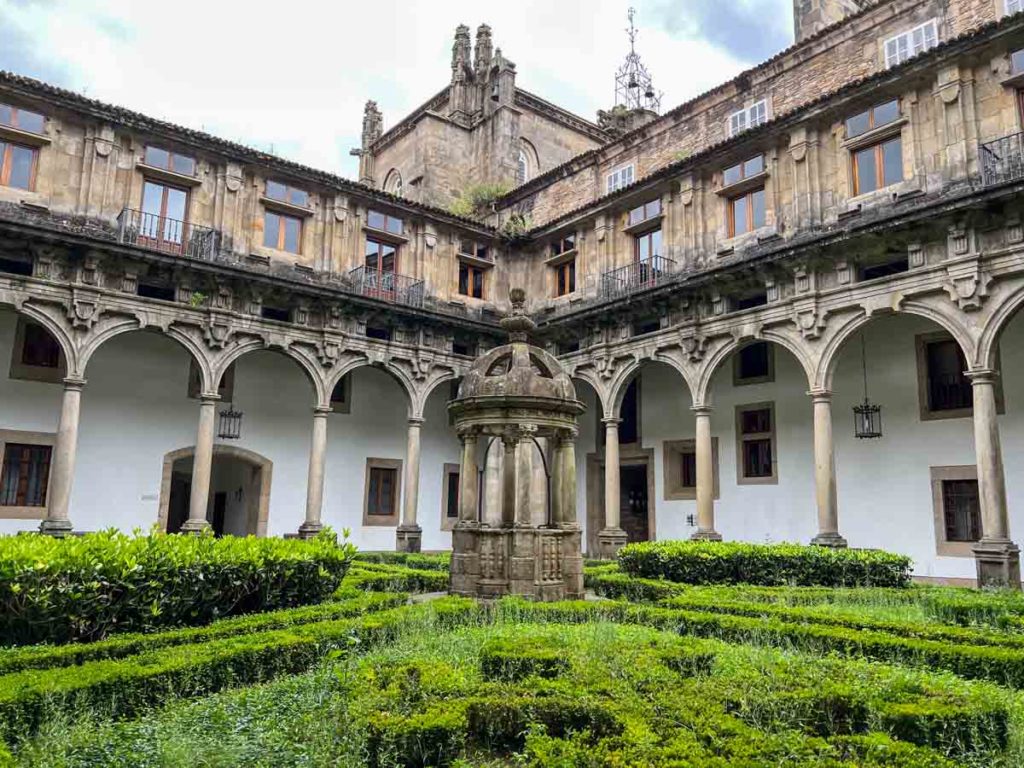History of the Camino de Santiago
The Camino de Santiago represents more than one thousand years of history and tradition. UNESCO has recognized the network of routes that converge in Santiago de Compostela as a significant factor in the cultural, historical, artistic, and architectural advances on the Iberian Peninsula.
By embarking upon your own pilgrimage, you can experience those traditions, find your spirituality, face your challenges and get into the flow of becoming a pilgrim.

What is the Camino de Santiago?
In English, “el Camino de Santiago” means “the Way of Saint James” and it represents the pilgrimage to the Cathedral of Santiago de Compostela in northwestern Spain. Legend has it that the remains of Jesus’s apostle Saint James the Greater lie in a silver casket under the Cathedral’s main altar. The pilgrimage to Santiago de Compostela has existed as a Christian pilgrimage for well over 1,000 years.
Throughout the medieval period, it was one of the three most important Christian pilgrimages undertaken. Indeed, it was only these pilgrimages—to Jerusalem, to Rome, and to Santiago de Compostela—which could result in a plenary indulgence, which frees a person from penance due to their sins.
The First Century Origins
Christian legend has it that at Pentecost when the Apostles divided the known world into missionary zones, the Iberian Peninsula fell to James. Seventh and eighth-century documents suggest that he spent a number of years preaching there before returning to Jerusalem, where in the year 44 CE he was beheaded by Herod Agrippa I. James was the first and only apostle whose death is recorded in the Christian Bible (Acts 12: 1-2).
After his martyrdom, a popular belief arose which says that Saint James’s followers carried his body to the coast and put it into a boat which miraculously sailed across the Mediterranean to land in northwestern Spain at Padrón, near the Ría Arousa on the Río Sar.
James’s disciples visited a local Roman matron, often referred to as “Queen Lupa,” asking for a site in which to bury St James. A series of trials, including an encounter with wild bulls on the Pico Sacro which were tamed at the sight of James’s body, allowing themselves to be yoked to pull the cart with the body back to Lupa which led to her conversion. She then provided a small marble tomb where St James (and later two of his disciples) could be buried. And there, the body lay forgotten until the 9th century.

The Discovery of Saint James’s Burial Site
In c.814 CE, Pelagius (AKA Pelayo or St Paio), a hermit living in Solovio (near the current cathedral) saw lights flickering in the forest. Exploring their appearance, he discovered an ancient tomb containing three bodies. He immediately reported this to the local bishop, Teodomiro (of Iria Flavia). The bishop declared the remains to be those of Santiago and two of his followers. Teodomiro then reported the finding to Alfonso II, King of Asturias. The king immediately traveled from his court in Oviedo to visit the tomb. This route, from Oviedo to Compostela, is now known as the Camino Primitivo, because it is considered the first pilgrimage route to the tomb.
Alfonso II commanded a church to be built at the site, known today as Santiago de Compostela. Modern folk etymology would have us believe that “Compostela” derives from “field of stars” but linguistically this is not possible. In actuality, it derives from a form of the Latin componere or compositum meaning “to bury” or “cemetery”.
News of the discovery spread, and more and more pilgrims began to arrive. Over the centuries Alfonso II’s church was replaced by a larger one. A second larger church was built over the first, but this one was destroyed when Almanzor sacked Santiago de Compostela, vandalized the church, but left the tomb intact. Construction on the current cathedral began in 1075 and it was consecrated in 1211. (The baroque façade seen today from the Obradoiro plaza was added in the mid-18th century.)
Miracles began to be attributed to Saint James. This was all greatly encouraged by Santiago de Compostela’s powerful Archbishop Diego Gelmírez (1069 – 1140) and the cathedral authorities, who were anxious to promote Santiago as a pilgrimage destination, as well as by the Benedictine monks of the Abbey of Cluny in France who were anxious to support the Spanish Church in its struggle against the Moors on the Peninsula.
The Camino in the Middle Ages
Pilgrimage to Santiago de Compostela reached its peak during the Middle Ages and it is safe to say that it constituted a major cultural aspect of that period of history in Europe. A 12th century witness, the Liber Sancti Jacobi, (commonly known by the name of its most famous manuscript, the Codex Calixtinus) brought together sermons, liturgies and music, miracle tales, stories of James’s death and the translation of his body to Galicia, an epic story of Charlemagne’s incursion onto the peninsula, and even a guide to what has become known as the Camino Francés, in five distinct books.
In addition, a massive infrastructure was developed to support pilgrimage, and not coincidentally, to gain commercially from it. Bridges were constructed across rivers to draw pilgrims to certain cities . . . and the cities prospered. Pilgrim hospitals were chartered by religious orders, kings, and queens (done for charitable purposes and also to gain favor in heaven). All manner of commercial businesses were established to both take advantage of and support pilgrims. Cultures mixed, languages merged, and history was affected.
The Significance of the Shell Symbol
The pecten maximus scallop shell was abundant along the Galician coastline. Early on, pilgrims took these shells home as a symbol of their arrival to Saint James’s tomb. They served as badges and remembrances of their pilgrimage and its lessons. A famous sermon from Book I of the Codex Calixtinus, the Veneranda dies (“Blessed be the day”) explains their symbolism:
“There are, then, some fish in the sea of Saint James that the people call veras (scallops), having two shields, one on either side, between which the fish is concealed. …These shells are chiseled like the fingers of a hand… [and] represent the two commandments of charity with which the bearer must truly protect his life: that is, to love God above all things and to love one’s neighbor as oneself.” [The Sermons and Liturgy of Saint James, Italica Press, 2021, p.250]
A later story incorporates shells in a miraculous intervention. It is said the boat carrying Saint James’s boat arrived near Finisterre as a wedding was taking place. The bridegroom was on horseback, and upon seeing this mysterious ship approaching, the horse spooked, plunging both the horse and rider into the sea. Miraculously, the horse with its rider emerged from the waves safe and sound, both covered with cockleshells.
The scallop shell remains the symbol of Saint James and the Camino. Today, many pilgrims carry or wear scallop shells as symbols of their intention or devotion.

The Camino’s Decline
After peaking in the Middle Ages, the phenomenon of pilgrimage to Santiago tapered off. Several possible causes or contributing factors have been cited. The Reformation initiated by Martin Luther around 1520 CE, certainly would have had an effect, being deeply critical as he was of the practice of indulgences, a concept thoroughly intertwined with the pilgrimage to Santiago. At the end of the 16th century, Spain engaged in wars with both England and France, effectively cutting off access to Spain from elsewhere in Europe.
Two centuries later, the Age of Enlightenment certainly did not encourage its rejuvenation. But throughout all of this, the pilgrimage to Santiago never quite died out. One small piece of evidence of its continuation comes from the journals of John Adams who, while making a land crossing from the Galician coast to Paris in December 1779, wrote that he “. . . always regretted that we could not find time to make a pilgrimage to Santiago de Compostela.”

The Camino’s Resurgence
In the late 19th century, excavations under the cathedral altar area rediscovered the bones of St James which had been hidden by a cathedral priest to prevent them from desecration by possible raids of the British privateer Sir Francis Drake (1540-1596). Pope Leo XIII (1878-1903) confirmed the authenticity of the relics to be those of St James and his two disciples Teodoro and Atanasio in the bull Deus Omnipotens (1884). At this time pilgrimage to Santiago de Compostela remained more regional (Galicia and northern Portugal) than national or international.
During and immediately following the Spanish Civil War (1936-1939) Francisco Franco reinstated the Voto de Santiago, a symbolic national offering made to the Santiago cathedral in honor of the St James’s support in the supposed Battle of Clavijo (844 CE). In the 1960s the Franco dictatorship began to develop the Camino as a motorized route to encourage historic tourism, renovating the Hostal de los Reyes Católicos in Compostela, and the Monasterio de San Marcos in León as 5-star hotels. Highway signposts marked important religious sites related to the pilgrimage. In Holy Year 1971, Elías Valiña Sampedro (1929-1989), priest of O Cebreiro, published Caminos a Compostela: Guía, a guidebook that detailed the historic walking route and sites to be visited along it.
The walking trail began to be marked in the late 1970s at various stages. The best known of these markings is the yellow arrow (beginning c. 1982) which has become the international symbol of the Santiago Caminos. The stone distance markers were added in 1986. In 1989, additional changes to a pilgrim’s journey occurred with the requirement that pilgrims carry a “credencial”, a type of pilgrim passport, that must be stamped along the way. (The Santiago cathedral was given exclusive control of the official credential in 1992.) This document is still required in order to obtain the final pilgrim document, the Compostela, as well as to gain access to some municipal pilgrim albergues (pilgrim hostels).
Holy Year 1993 was a watershed year in the development of the Camino. The Galician government promoted and encouraged the pilgrimage, and since that year the number of pilgrims has increased exponentially.
Some aspects of the modern Camino are fundamentally the same as they were for the medieval pilgrim. As a practical affair, the Camino is a good long walk. While underway, the pilgrim needs support for food, lodging and direction. An infrastructure of hospitals arose in the Middle Ages and this infrastructure still exists – and in fact, it is growing rapidly. There are still facilities run by religious orders, but you’ll also find albergues or pilgrim hostels which are run by local towns or private businesses.
The medieval pilgrim was nearly always undertaking the arduous journey for serious religious reasons– often to seek forgiveness for sins or to ask for the Saint’s assistance in some matter. The modern pilgrim’s reasons for walking surely span the range from religious to spiritual, psychological, historical, cultural, and for the physical challenge.
Probably the most obvious and serious difference between the medieval and the modern pilgrim is that pilgrimage for the former began on his or her doorstep, wherever that might have been, and upon reaching Santiago, the pilgrimage was only half over, as they needed to then walk home. Since 1989 a minimum distance to be traveled on foot (100 km; 200km on bicycle or horseback) was instituted in response to the large numbers of parishes and persons making only symbolic pilgrimages to attend Pope John Paul II’s appearance at World Youth Day in Santiago de Compostela. Pilgrims walking this minimum distance must collect a minimum of two stamps or sellos (pronounced SAY-yohs) on their credential to earn a Compostela.
(Thank you to Maryjane Dunn, Lynn Talbot and Gene McCullough for their contributions to this page.)
More Camino Resources
If you want to get started with that credential, you can order it from us before you go.
For a look at all of those UNESCO heritage routes to Santiago de Compostela, check out our Camino routes page.
We also have FAQs on planning your Camino and what to expect while on the trail. If you want some inspiration, check out our list of books, movies, and podcasts which feature folks sharing their experiences. And get pilgrim stories, poetry and updates from us over at our La Concha magazine.
Join the community by becoming a member of the American Pilgrims on the Camino, engaging with a local chapter or joining our general American Pilgrims Facebook group.
Rev 11/20/2024

